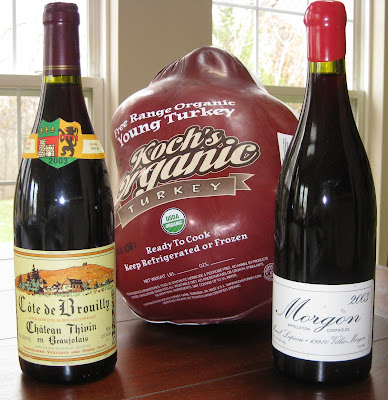
This was the first Thanksgiving day hosted at Chez Bobo and it proved to be more work than expected. Granted, my wife awoke at 5am to begin the cooking, but I am in charge of the dish cleaning and this proved to be a momumental task. I underestimated the number of dishes that would be involved in preparing the feast and spent a good portion of the afternoon cleaning up. The great food and wine made it all worth it, however. A nice sparkling Vouvray Brut from Domaine Aubuisieres got the festivities off to a good start. Next up, a rich and creamy Jean Velut, Champagne, Blanc de Blanc, NV that was very good.

I love the rieslings from the Wachau region of Austria, but I also enjoy the gruner veltliners made in the Federspiel style (12.5% maximum alcohol). Their are four producers in the Wachau that are often sited as the best and we tasted Federspiels from three of these estates. Due to the difficulty in obtaining their wines, Knoll was not included. The Hirtzberger, Gruner Veltliner, Federpiel, Rotes Tor, 2006 was nice, but seemed hard and bitter next to the competition. Richer and rounder on the palate was the Prager, Gruner Veltliner, Federspiel, Hinter der Burg, 2006. I was surprised at how much I enjoyed this wine, because in the past I found those from Prager to be little too clean and soulless. On this day, the Prager tasted delicous and showed great balance. The company I work for distributes the wine, so I may seem biaised, but I found the F.X. Pichler, Gruner Veltliner, Federspiel, Klostersatz, 2006 to be the best of the flight. Typical of the wines from this estate, the Pichler had a seemless texture that gave it a greater sense of elegance. Hirtzberger and Prager are terrific producers, but the wines from F.X. Pichler show the touch of a truly gifted winemaker.

Ironically, after my earlier post declaring that gamay based wines work best on Thanksgiving, I did not open a single Beaujolais. I had every intention of cracking open a couple cru bottlings, but my brother in-law showed up with two grand cru wines from the Cote d'Or. What would you expect the Burgschnauzer to do? The Jacky Truchot, Clos de la Roche, Grand Cru, 2003 was an obvious "leaker," but the wine still showed pretty well. Although it appeared rather advanced for its age, the wine was complex and elegant. The Domaine des Lambrays, Clos des Lambrays, Grand Cru, 2003 was a perfect bottle and showed well, but I was a little disappointed with the roasted flavor it displayed. The more Burgundies I drink from 2003, the less I like the vintage.

Despite this being the first Thanksgiving at Chez Bobo, the turkey turned out great and the entire meal was a success. The next night, we attempted to plough through some of the leftovers and this time we drank a Beaujolais. Confirming my earlier claims, a bottle of Domaine Vissoux, Fleurie, Poncie, 2007 was a perfect match for the meal. The wine washed down the various foods without any conflict. Next year, I will be sure to crack open some cru Beaujolais. Although, I might be persauded otherwise if someone shows with up with a couple grand cru Burgundies.




